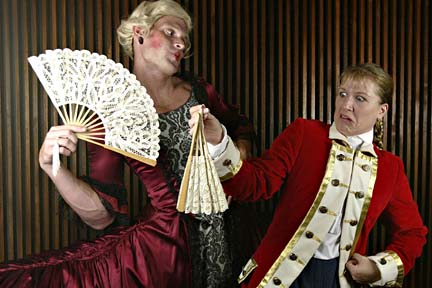
[ REVIEW ]
ANDREW SHIMABUKU PHOTO
Justin Grimes, left, is dressmaker Rose Bertin, and Jessica L. Jacob plays Charles Genevieve d'Eon de Beaumont, in the University of Hawaii production of "Masked Balls."
UH play explores
gender power
Was Charles Genevieve d'Eon de Beaumont a man who dressed as a woman while serving France as a diplomat and spy? Or, was d'Eon a female whose parents had forced her to pose as male from childhood to ensure a family inheritance? That question is left unanswered by playwright Hilary Hadley Wright as she explores the relationship between power and gender with "Masked Balls" at the University of Hawaii at Manoa Ernst Lab Theatre.
Program notes explain that d'Eon achieved fame and fortune in 18th century France as a soldier and enjoyed success thereafter as a diplomat and spy. Rumors that d'Eon was a male impersonator reached Louis XV about the same time that d'Eon was demanding payment for expenses incurred while working as a diplomat/spy in England. D'Eon was threatening to leak information to the British unless payment was made.
"Masked Balls": Presented by the University of Hawaii Manoa Department of Theatre and Dance at Ernst Lab Theatre, 8 p.m. today and 2 p.m. tomorrow. Admission is $10; $8 seniors, military, UH faculty and staff, and non-UH students; $3 UH students with Fall 2003 I.D. Call 956-7655.
Louis decided d'Eon was a trouble-maker and a female in drag and ordered "her" to return to France. D'Eon was eventually extradited and given a choice: Execution for treason if he was male, or life as a lady of leisure if "he" was female. If d'Eon chose life he/she would have to dress and live as a woman.
Wright doesn't explain why French authorities didn't simply check d'Eon's physical gender and act accordingly, but this allowed d'Eon to choose life.
IN KEEPING WITH the theme, Wright utilizes gender neutral casting. Several minor male characters are played by women, and the role of Marie Antoinette's female dressmaker is played a male (Justin Grimes) who affects an over-the-top fa-laming transvestite persona that is stereotypical at best.
Wright is more imaginative in following the example set by Dennis Carroll's brilliant 2001 staging of "Faust I"/"Faust II" and dividing d'Eon's psyche into male and female halves. While Carroll had Moses Goods and Helen Lee play the male and female halves of Mephistopheles' psyche, Wright has Jessica Lee Jacob cross-dressing in 18th century male attire to represent the male side of d'Eon's psyche. Pedro Haro plays d'Eon as a woman and wears comparable female attire.
The two d'Eons share the spotlight as the story hop-scotches back and forth through roughly 60 years of French history. They spend most of it bickering over whether he/she made the right choice in agreeing to live as a woman. The female d'Eon (Haro) argues that she did. The male d'Eon (Jacob) argues that she/he/they did not. Given that the alternatives were death or, possibly, betraying France by defecting, the male d'Eon has a difficult case to make and does not do so convincingly.
Jacob plays d'Eon as a dashing male impersonator in early scenes and a study in frustration thereafter. Haro gives a broader, more artistically satisfying performance playing a woman whose gender is suspect. Haro, or, rather, the "female" d'Eon, makes the more convincing argument that women who dress as women can still wield power even if they do so by manipulating men.
Ironically, perhaps, the "male" d'Eon's downfall was engineered by one such woman, the Marquise de Pompadour, who was Louis' mistress for five years. Mimi Sadoshima plays Pompadour with a delicious poisonous charm that suggests both the sex appeal and lethal sting of Louis' paramour.
She figures prominently in Act II when Pompadour -- now dead -- visits the "female" d'Eon in the company of Joan of Arc (Nicole Tessier) to further debate issues of dress and gender roles. (For those fuzzy on French history, Joan of Arc dressed as a male and led French forces in battle. She was burned at the stake as a relapsed heretic in 1431 in part because she continued to dress as a male.)
No mention is made of Elizabeth I of England, who overcame adversity as a young woman to become one of the toughest and most successful monarchs in English history, but Czarina Elizabeth of Russia appears in several scenes as a shrewd and powerful female autocrat. Stephanie Kong's spirited portrayal of Elizabeth adds several welcome jolts of energy to the slow-moving production.
The impact Kong and Sadoshima bring to the show is enhanced by the work of Jennifer Bolieu (hair and makeup design) and Megan Patton (costume design).
Adrian Martin (Comte de Broglie) gives an entertaining performance as an opportunistic diplomat. Grimes' performance as a gay male transvestite is a cliché but was a big hit with the student audience on Thursday. The six women in the ensemble who play most of the minor characters employ such stilted delivery that it's unclear whether they are struggling to remember their lines or intended to sound like airheads.
"Masked Balls" is staged primarily in the round with only a few benches as set pieces, but one character performs in a corner, and a significant amount of action takes place behind the Diamond Head side seats. The ewa and makai seats provide the best view of the action.
Jacob's sword-fight choreography adds welcome action scenes. Daniel Morse's original music is played on something that sounds close enough to a harpsichord to add the period ambiance, and Lara Bowles' choreography may be there in part to allow adequate time for costume changes but always suffices to advance the action. The titular "masked balls" encounter between d'Eon (Haro) and Kong (Elizabeth) is beautifully staged and executed.
Click for online
calendars and events.

